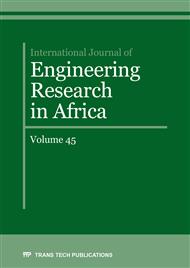[1]
S. Ganguly, Human error vs work place management in modern organizations. Int. J. Res. Mgt. & Tech., 1(2011) 1-5.
Google Scholar
[2]
J.R.E. Saward, N.A. Stanton, Individual latent error detection and recovery in naval aircraft maintenance: introducing a proposal linking schema theory with a multi-process approach to human error research, Theo. Iss. Ergo. Sci., 16 (2015) 255-272.
DOI: 10.1080/1463922x.2014.969360
Google Scholar
[3]
CAA Aircraft Maintenance Incident Analysis CAP 1367, Published by the Civil Aviation Authority, (2015). Retrieved from https://publicapps.caa.co.uk/docs/33/CAP%201367%20template%20w%20charts.pdf.
Google Scholar
[4]
K. Latorella, P.V. Prabhu, (1997). A review of human error in aviation maintenance and inspection, Int. J. of Ind. Erg, 26 (2000) 133-161.
DOI: 10.1016/s0169-8141(99)00063-3
Google Scholar
[5]
A. Hobbs, A. Williamson, Associations Between Errors and Contributing Factors in Aircraft Maintenance, Hum. Fac. 45 (2003) 186-201.
DOI: 10.1518/hfes.45.2.186.27244
Google Scholar
[6]
R.C. Graeber, D.A. Marx, Reducing human error in aircraft maintenance operations, Proc. of the 46th Ann. Int. Air Saf. Sem., (1993) 147–160.
Google Scholar
[7]
R. Baron, The challenges of an Error Reporting System, (2008). Retrieved from http://www.aviationpros.com.
Google Scholar
[8]
GAIN, A road map to a just culture; Enhancing the safety environment, Glo. Avia. Inf. Net. (2004). Retrieved from https://flightsafety.org/files/just_culture.pdf.
Google Scholar
[9]
ARL, A Synthesis of Safety Culture and Safety Climate Research, (2002) 1-22. https://www.nrc.gov/docs/ML1025/ML102500649.pdf.
Google Scholar
[10]
FAA, BOEING- Maintenance Error Decision Aid (MEDA) User's Guide (2013). https://www.faa.gov/about/initiatives/maintenance_hf/library/documents/media/media/meda_users_guide_updated_09-25-13.pdf.
Google Scholar
[11]
S. Nallusamy, A proposed model for lead time reduction during maintenance of public passenger transport vehicles, Int. J. Eng. Res. Afr. 23 (2016) 174-180.
DOI: 10.4028/www.scientific.net/jera.23.174
Google Scholar
[12]
S. Nallusamy, K. Balakannan, P.S. Chakraborty, G. Majumdar, Reliability analysis of passenger transport vehicles in public sector undertaking, Int. J. App. Eng. Res, 10 (2015), 843-850.
Google Scholar
[13]
Y. Donchin, D. Gopher, M. Olin, Y. Badihi, M. Biesky, C. L. Sprung, R. Pizov, S. Cotev A look into the nature and causes of human errors in the intensive care unit. Qual. Saf. Health Care, 12(2003) 143–148.
DOI: 10.1097/00003246-199502000-00015
Google Scholar
[14]
K. W. Jan, L. Y. Patrick, A system of safety management practices and worker engagement for reducing and preventing accidents: An empirical and theoretical investigation. Acci. Anal. & Prev. J. 68 (2014) 117–130.
DOI: 10.1016/j.aap.2013.07.029
Google Scholar


